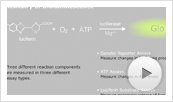Bioluminescent Assays for High-Throughput Screening
Publication Date: 2007
Abstract
In the development of high-throughput screening (HTS) as a central paradigm of drug discovery, fluorescence has generally been adopted as the favored methodology. Nevertheless, luminescence has maintained a prominent position among certain assay formats, most notably genetic reporters. Recently, there has been growing partiality for luminescent assays across a wider range of applications due to their sensitivity, broad linearity, and robustness to library compounds and complex biological samples. This trend has been fostered by the development of several new assay designs for diverse targets such as kinases, cytochrome p450s, proteases, apoptosis and cytotoxicity.
This review addresses recent progress made in the use of bioluminescent assays for HTS, highlighting new detection capabilities brought about by engineering luciferase genes, enzymes, and substrates. In genetic reporter applications, modifications to the luciferase genes have improved assay sensitivity by substantially increasing expression efficiency and enhanced response dynamics by reducing expression lifetime. The performance of assays based on detection of ATP and luciferin has been enhanced by modifications to the luciferase enzyme that increase its chemical and physical stability. Detection of ATP allows rapid analysis of cell metabolism and enzymatic processes coupled to ATP metabolism. Because luciferins are not naturally associated with mammalian physiology, assays for luciferin detection utilize synthetic derivatives designed to yield luminescence only when coupled with specific target enzymes. Finally, new methods for modulating the specific activity of luciferases are leading to the development of intracellular biosensors for dynamic detection of physiological processes.
This article originally appeared in ASSAY and Drug Development Technologies, Volume 5, Number 1, 2007.
 Learn about the chemistry of the bioluminescent reaction and its use in a broad range of assays.
Learn about the chemistry of the bioluminescent reaction and its use in a broad range of assays.